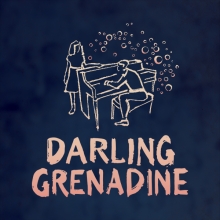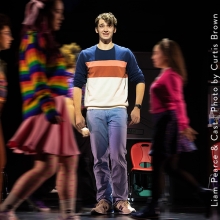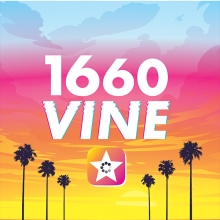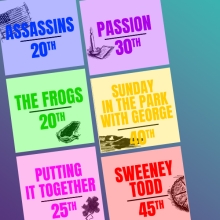
Full Synopsis
Act One
As the music begins, the lights come up on three women sitting in what look like individual hotel rooms in a worn-down dive. The women are in period dress, reflecting Chicago in the late 1930s. The Lady from the Road, a warm and beautiful woman in her late 50s or early 60s, has surrounded herself with memories of her brighter past. The Woman of the World, a stylish creature of indeterminate age, surrounded by an equal amount of perfume and liquor bottles, spends the evening preparing for her gentleman caller. The Girl With a Date sits in a sparsely decorated room determined to make a fresh start in the big city. Behind them, The Man in the Saloon, at once charming and dangerous, watches with a wary eye and comments with a silver tongue.
The Women sing from their individual areas as they set the stage for the evening. As much as they long for a man to hold them, they're alone ("Blue Blues"). The Man, in the band area, sings about his hard luck as the women dream of a better time to come ("Four Wall Blues / I've Gotta Date with a Dream"). The Man hangs out with the band as the Lady addresses the audience. She introduces the characters on stage, then changes into a flashy costume from her days as a singer. She sings "New Orleans Hop Scop Blues" as she shimmies and dances.
The Woman sits in her armchair and reminisces of days gone by. As she sings, her room is temporarily transformed into a dance hall ("Stompin' at the Savoy"). She sprays herself with perfume as the lights crossfade to the Girl. The Girl turns on her radio and recognizes the tune ("Taking a Chance on Love").
Addressing the audience, The Lady remembers what good, old loving used to feel like. The Woman and the Girl add their voices from their rooms, taking turns and backing her up ("It Makes My Love Come Down").
The Lady goes behind her screen to change as the Girl exits, leaving the Woman alone on stage. She puts on a dressing gown with great style ("Lush Life"). The man appears in another part of the stage, singing, then exits. At the end of the song, the Woman exits, leaving the stage bare.
The Man enters alone and dreams of a better life — the life he wishes that he had ("I'm Just a Lucky So and So"). The Lady enters in a brightly colored riding outfit, complete with parasol ("Take Me for a Buggy Ride"). The Man sings "Wild Women Don't Have No Blues," singing to each of the women, instructing them. The Women respond with "Lover Man," then join him in "Wild Women Don't Have No Blues."
The Girl, feeling lonely, sings "Willow Weep for Me." The Man shakes his head and exits as The Lady reenters in a large feathered hat and too much costume jewelry, singing a raunchy song about the kind of man that she needs ("Kitchen Man").
The Girl and The Woman enter from opposite sides and sing "When Your Lover Has Gone." The Lady joins them, and they sing "Take It Right Back," proclaiming that they are done with low-down, dirty-dog men.
Act Two
The lights come up on each person as they begin to sing. They are alone in their individual areas ("Blues in the Night"). The singers have become more and more undone, drinking steadily and slowly over the course of the evening. The shine is beginning to wear off as they reveal their true situations. The Lady addresses the audience, explaining that it's "Blues Time" — around three in the morning. The Girl's date never showed up, The Woman never had anyone to begin with, and the Lady is alone with her memories. The Lady says that she needs to talk to the women in the audience, and tells the men to either leave or cover their ears. The other Women back her up ("Dirty No-Gooder Blues").
The Man and the Women trade off as they talk about their worn-down hearts. The Man wishes for a woman to love him the way he is. The Women lament over how untrustworthy men can be ("When a Woman Loves a Man / Am I Blue"). As the Man starts to leave, The Woman comes downstage and focuses on him, singing that she wants a "Rough and Ready Man" — one who isn't afraid to work. The Man shivers and exits as The Woman gets more and more carried away.
The Girl, sitting at the table in her room, is clearly a little drunk. She feels that she's growing old and has to live while she can, teasing the men in the audience with the "Reckless Blues." The rest of the stage goes dark and The Lady is taking one last look at her scrapbook and sings the "Wasted Life Blues." She lies down on her bed as if she intends never to get up again. The Man enters and sings "Baby Doll," looking at The Lady. He turns to the audience and turns up the heat, then struts off cockily.
The Woman sits alone at her vanity, staring into the mirror ("Nobody Knows You When You're Down and Out"). The Lady and The Girl add their voices to hers.
In the Finale, all four singers join in "I Gotta Right to Sing the Blues / Blue Blues." We are left with an emotional impression of what life was like in the late 1930s in Chicago — good music, hard lives and dreams that stretch on long into the night.
Show History
Inspiration
Blues in the Night is both inspired by, and a send-up to, the indigenous American art form known as the blues, and some of the songs and voices that made it what it is.
Productions
Blues in the Night is a musical revue conceived by Sheldon Epps, featuring the torch songs and blues of Duke Ellington, Bessie Smith, Johnny Mercer, Harold Arlen, Vernon Duke, Gordon Jenkins and Alberta Hunter, among others.
The revue was originally staged at the Off-Broadway Playhouse 46 by Sheldon Epps and Gregory Hines (under the supervision of Norman Ren), where it ran from March 26, to May 11, 1980, for 51 performances. David Brunetti, Rise Collins, Suzanne M. Henry and Gwen Shepherd comprised the original cast.
Blues in the Night then moved uptown to Broadway, where it began previews on May 20, 1982, and opened at the Rialto Theatre on June 2, 1982. Directed by Epps, the cast included Jean Du Shon, Debbie Shapiro, Leslie Uggams and Charles Coleman. Although the show only played 53 performances, it was nominated for the Tony Award for Best Musical .
After New York, Blues in the Night took to London, opening in the West End at the Donmar Warehouse on June 9, 1987. Staged by Steve Whately, it starred Maria Friedman, Debby Bishop, Carol Woods and Clarke Peters. It ran through July 19, 1987, before transferring to the Piccadilly Theatre for a September 23, 1987, to July 28, 1988, run.
On September 14, 1988, a revival production opened Off-Broadway at the Minetta Lane Theatre in New York City. It ran for 45 performances through October 23, 1988, and featured Carol Woods, Brenda Pressley, Kathleen Rowe McAllen and Lawrence Hamilton in the cast.
In addition to these high-profile productions, Blues in the Night has played to much success in various regional theatres throughout the country, including those in Chicago, Boston, San Francisco, Minnesota and Milwaukee, to name a few.
Cultural Influence
- On August 25, and 26, 1987, during the initial London run of Blues in the Night at the Donmar Warehouse, live recordings of the cast were made and compiled into one cast album released by First Night Records.
Trivia
- Blues in the Night received a nomination for Best Musical at the 1983 Tony Awards, as well as nominations for Best New Musical and Best Actress in a Musical at the 1987 Laurence Olivier Awards.
- For the 1982 Broadway run of Blues in the Night, legendary singer, Ruth Brown, played The Lady in previews but, due to her ailing health, was replaced when the show opened by Miss Jean DuShon, who went on to receive rave reviews, most notably for her interpretation of the tragic "Wasted Life Blues."
Critical Reaction
"The sauciest, nattiest and most goosebump-inducing tracks around... a heady evocation of a time gone by. And it's pure pleasure."
– Time Out London
"You'll be won over by this celebration of great old songs."
– San Francisco Gate
"Marvelous songs, all of them."
– Chicago Reader
"It works. Director Sheldon Epps, who first workshopped the play 15 years ago and brought it to Broadway two years later, meets his goal to entertain."
– Variety
"Blues in the Night, a revue of music from that moody, marvelous, moonlit genre, arrives at Bailiwick Repertory with promising advance word, and deservedly so."
– Chicago Tribune
Tony® Award
Connect
Billing
- Conceived and Originally Directed by
- Music and Lyrics by
Requirements
|
Original Vocal Arrangements and Musical Direction by
CHAPMAN ROBERTS
|
Orchestrations and Additional Vocal Arrangements by
SY JOHNSON
|
FOUR WALLS (AND ONE DIRTY WINDOW) BLUES
by Willard Robinson; by permission of The Jewel Music Publishing Co., Inc.
I'VE GOT A DATE WITH A DREAM
by Mack Gordon and Harry Revel; by permission of SBK/Feist Catalog, Inc.
NEW ORLEANS HOP SCOP BLUES
by George W. Thomas; by permission of Jerry Vogel Music Co., Inc.
STOMPIN AT THE SAVOY
by Benny Goodman, And Razaf, Edgar Sampson and Cick Webb; by permission of SBK Robbins
Catalogue, Inc. and RYTVOC, Inc.
TAKING A CHANCE ON LOVE
by Vernon Duke, John LaTouche and Ted Fetter; by permission by SBK Miller Catalogue, Inc.
IT MAKES MY LOVE COME DOWN
by Bessie Smith; used by permission of Frank Music Corp.
LUSH LIFE
by Billy Strayhorn; used by permission of Tempo Music, Inc.
I'M JUST A LUCKY SO-AND-SO
by Duke Ellington and Mack David; used by permission by T.B. Harms Company, a Polygram International Music Publishing Company and Famous Music Publishing Company
TAKE ME FOR A BUGGY RIDE
by Leola and Wesley Wilson; used by permission of Frank Music Corp.
WILD WOMEN DON'T HAVE THE BLUES
by Ida Cox; used by permission of Northern Music Company
LOVER MAN
by Jimmy Davis, Jimmy Sherman and Roger "Ram" Ramirez; used by permission of MCA Music Publishing
WILLOW WEEP FOR ME
by Ann?Ronell; used by permission of the Bourne Company
KITCHEN MAN
by Andy Razaf and Wesley Wilson; used by permission of MCA Music Publishing
WHEN YOUR LOVER HAS GONE
by E.A. Swan; used by permission of Warner Bros., Inc.
TAKE IT RIGHT BACK
by H. Grey
by Ida Cox; by permission of Northern Music Company
BLUES IN THE NIGHT
by Harold Arlen and Johnny Mercer; by permission of Warner Bros., Inc.
DIRTY NO-GOODER'S BLUES
by Bessie Smith; used by permission of Frank Music Corp.
WHEN A WOMAN LOVES A MAN/AM I BLUE?
by Johnny Mercer, Gordon Jenkins and Bernard Hanighen/
by Grand Clarke and Harry Akst; used by permission of Chappell & Co.,/
used by permission of Warner Bros., Inc.
ROUGH AND READY MAN
by Alberta Hunter; used by permission of Alberta Hunter Music Co.
by Bessie Smith; used by permission of Frank Music Corp.
WASTED LIFE BLUES
by Bessie Smith; used by permission of Frank Music Corp.
BABY DOLL
by Bessie Smith; used by permission of Frank Music Corp.
NOBODY KNOWS YOU WHEN YOU'RE DOWN AND OUT
by Jimmy Cox; used by permission of MCA Publishing
I GOTTA RIGHT TO SING THE BLUES
by Harold Arlen and Ted Koehler; used by permission of Warner Bros., Inc.
FOUR WALLS
(Reprise); used by permission of Jewel Music Publishing Co., Inc.
Video Warning
In accordance with the Performance License, you MUST include the following warning in all programs and in a pre-show announcement:ANY VIDEO AND/OR AUDIO RECORDING OF THIS PRODUCTION IS STRICTLY PROHIBITED.
Included Materials
| Item | Quantity Included |
|---|---|
| LIBRETTO/VOCAL BOOK | 8 |
| PIANO CONDUCTOR'S SCORE | 2 |
Production Resources
| Resource |
|---|
| HOW DOES THE SHOW GO ON-10/CS |
| HOW DOES THE SHOW GO ON? |
| PRODUCTIONPRO-DIGITAL SCRIPT/SCORE |
| REFERENCE RECORDING |
| STAGE WRITE APPLICATION |
STANDARD ORCHESTRATION
| Instrumentation | Doubling |
|---|---|
| BASS | |
| DRUMS | KIT , WOOD BLOCK |
| REED 1 | CLARINET , TENOR SAXOPHONE , TRUMPET |
| TRUMPET |




